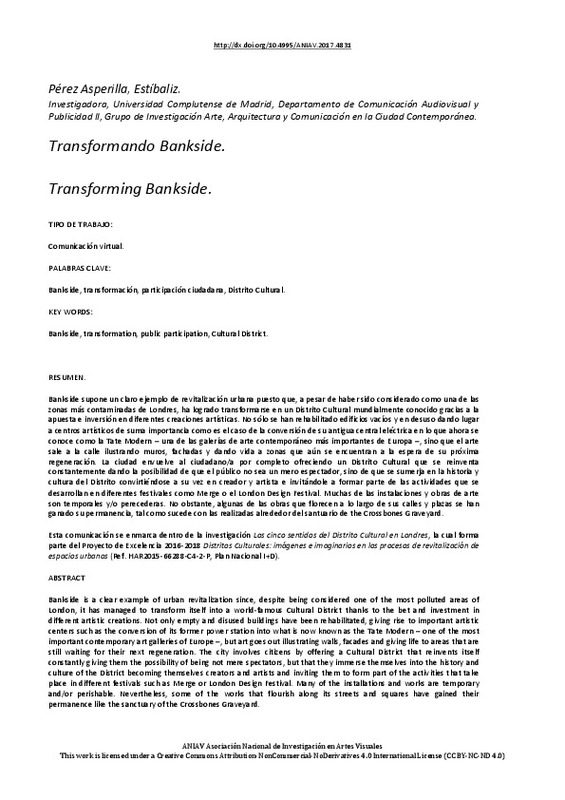JavaScript is disabled for your browser. Some features of this site may not work without it.
Buscar en RiuNet
Listar
Mi cuenta
Estadísticas
Ayuda RiuNet
Admin. UPV
Transformando Bankside
Mostrar el registro sencillo del ítem
Ficheros en el ítem
| dc.contributor.author | Pérez Asperilla, Estíbaliz
|
es_ES |
| dc.date.accessioned | 2018-09-11T06:51:47Z | |
| dc.date.available | 2018-09-11T06:51:47Z | |
| dc.date.issued | 2017-10-23 | |
| dc.identifier.isbn | 9788490485736 | |
| dc.identifier.uri | http://hdl.handle.net/10251/106968 | |
| dc.description.abstract | [EN] Bankside is a clear example of urban revitalization since, despite being considered one of the most polluted areas of London, it has managed to transform itself into a worldefamous Cultural District thanks to the bet and investment in different artistic creations. Not only empty and disused buildings have been rehabilitated, giving rise to important artistic centers such as the conversion of its former power station into what is now known as the Tate Modern – one of the most important contemporary art galleries of Europe –, but art goes out illustrating walls, facades and giving life to areas that are still waiting for their next regeneration. The city involves citizens by offering a Cultural District that reinvents itself constantly giving them the possibility of being not mere spectators, but that they immerse themselves into the history and culture of the District becoming themselves creators and artists and inviting them to form part of the activities that take place in different festivals such as Merge or London Design Festival. Many of the installations and works are temporary and/or perishable. Nevertheless, some of the works that flourish along its streets and squares have gained their permanence like the sanctuary of the Crossbones Graveyard. This paper is part of the research Five senses of London Cultural District, which forms part of the Excellence Project 2016e 2018 Cultural Districts: images and imaginaries in the revitalization process of urban locations (Ref. HAR2015e66288eC4e2eP, I+D National Plan). | es_ES |
| dc.description.abstract | [ES] Bankside is a clear example of urban revitalization since, despite being considered one of the most polluted areas of London, it has managed to transform itself into a worldefamous Cultural District thanks to the bet and investment in different artistic creations. Not only empty and disused buildings have been rehabilitated, giving rise to important artistic centers such as the conversion of its former power station into what is now known as the Tate Modern – one of the most important contemporary art galleries of Europe –, but art goes out illustrating walls, facades and giving life to areas that are still waiting for their next regeneration. The city involves citizens by offering a Cultural District that reinvents itself constantly giving them the possibility of being not mere spectators, but that they immerse themselves into the history and culture of the District becoming themselves creators and artists and inviting them to form part of the activities that take place in different festivals such as Merge or London Design Festival. Many of the installations and works are temporary and/or perishable. Nevertheless, some of the works that flourish along its streets and squares have gained their permanence like the sanctuary of the Crossbones Graveyard. | es_ES |
| dc.format.extent | 7 | es_ES |
| dc.language | Español | es_ES |
| dc.publisher | Editorial Universitat Politècnica de València | es_ES |
| dc.relation.ispartof | Glocal [codificar, mediar, transformar, vivir] III Congreso Internacional de Investigación en Artes Visuales | es_ES |
| dc.rights | Reconocimiento - No comercial - Sin obra derivada (by-nc-nd) | es_ES |
| dc.subject | Bankside | es_ES |
| dc.subject | Transformación | es_ES |
| dc.subject | Participación ciudadana | es_ES |
| dc.subject | Distrito cultural | es_ES |
| dc.subject | Transformation | es_ES |
| dc.subject | Public participation | es_ES |
| dc.subject | Cultural district | es_ES |
| dc.title | Transformando Bankside | es_ES |
| dc.title.alternative | Transforming Bankside | es_ES |
| dc.type | Capítulo de libro | es_ES |
| dc.type | Comunicación en congreso | es_ES |
| dc.identifier.doi | 10.4995/ANIAV.2017.4831 | |
| dc.rights.accessRights | Abierto | es_ES |
| dc.description.bibliographicCitation | Pérez Asperilla, E. (2017). Transformando Bankside. En Glocal [codificar, mediar, transformar, vivir] III Congreso Internacional de Investigación en Artes Visuales. Editorial Universitat Politècnica de València. 869-875. https://doi.org/10.4995/ANIAV.2017.4831 | es_ES |
| dc.description.accrualMethod | OCS | es_ES |
| dc.relation.conferencename | III Congreso Internacional de Investigación en Artes Visuales :: ANIAV 2017 :: GLOCAL | es_ES |
| dc.relation.conferencedate | Julio 06-07,2017 | es_ES |
| dc.relation.conferenceplace | Valencia, Spain | es_ES |
| dc.relation.publisherversion | http://ocs.editorial.upv.es/index.php/ANIAV/ANIAV2017/paper/view/4831 | es_ES |
| dc.description.upvformatpinicio | 869 | es_ES |
| dc.description.upvformatpfin | 875 | es_ES |
| dc.type.version | info:eu-repo/semantics/publishedVersion | es_ES |
| dc.relation.pasarela | OCS\4831 | es_ES |








